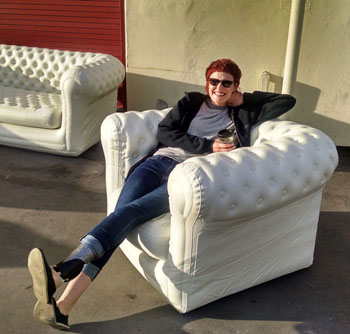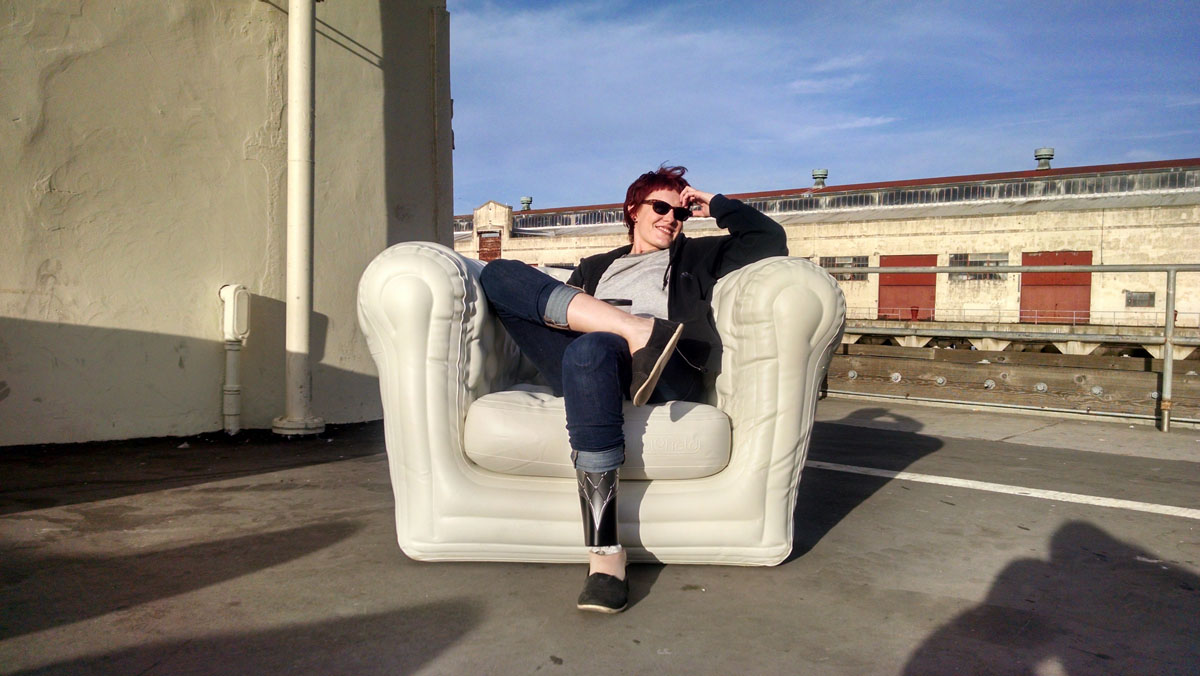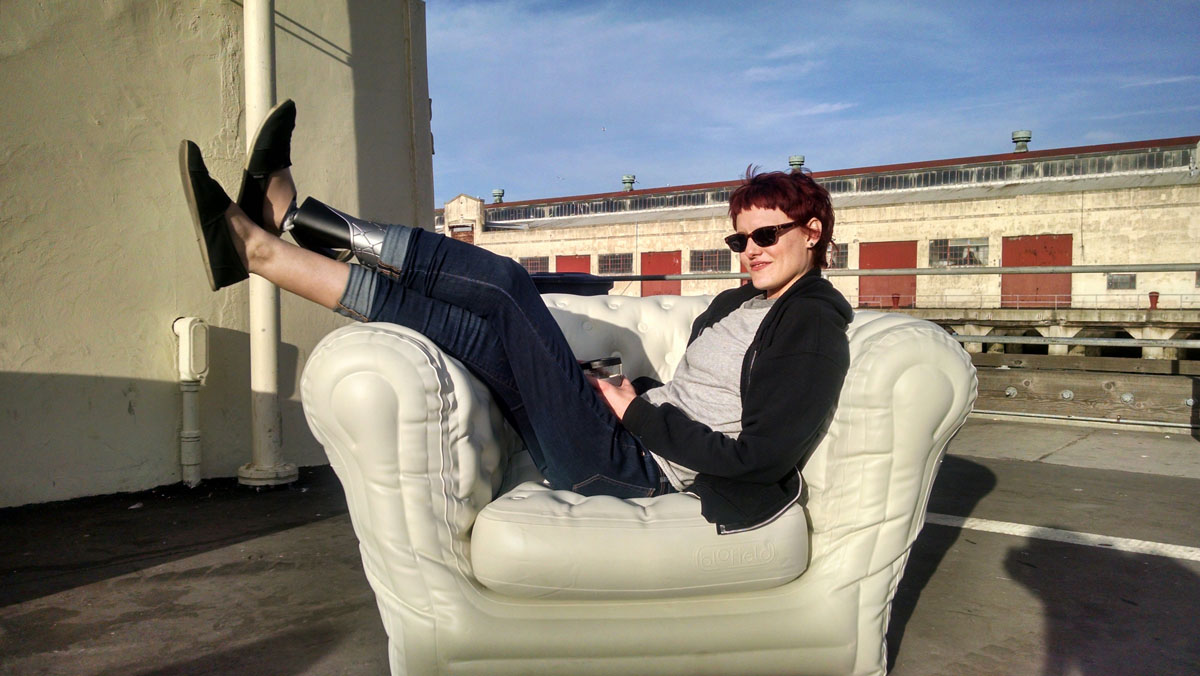At REAL 2015 last week, I had the pleasure of sitting down with Katherine Crawford who joined UNYQ founder Ethyor Bender on stage to talk about her experience with UNYQ’s 3D printed prosthetic covers. I was inspired by her presence and requested an interview with her. She kindly obliged and we got to talking, sitting outside Herbst Pavillion in comfy inflatable furniture. There were a few noisy birds that interrupted us here and there, but I captured most of the audio recording without a problem.
Andrew: Name and occupation?
Katherine: Katherine Crawford, Model and Actress.
Andrew: What is your origin story?

Andrew: Where did the injury occur?
Katherine: The injury occurred here in the states. I injured it originally in 2009, during a live fire training mission. I jumped out of a vehicle and, from the medical records, it said that I snapped the tibia when I landed. I went home and asked them for help. They didn’t really know what to do with me; I was basically asked to perform my duties as we all are. As a result of that, the leg got damaged more and more. Finally, I was on my way to Afghanistan and that is when it busted for the final time – just couldn’t handle it. I was very quickly put in a rear detachment unit, which is a unit in waiting. When they found that I could no longer perform my duties – I couldn’t heal, I was not going to recover – they honorably discharged me in 2011. Still had the leg.
At that point in time, I went to the Veteran’s Affairs System and they very quickly put me in a wheelchair. And I was very pleased with my ability to ambulate, but it still wasn’t what I wanted; it still wasn’t the quality of life that I needed. So, 2012 rolled around and the amputation came and, literally ten days after the stitches came out, I was walking. I was up and around and on my way to having a much better quality of life than I was three years prior.
Andrew: That had to feel amazing.
Katherine: It was absolutely amazing. It was so astonishing to see, and I knew before that the benefits would increase if I requested the amputation. The benefits of mobility are just insanely taken advantage of by all of us. We don’t think about getting up from our bed and walking to the bathroom in the middle of the night. We never think about that kind of thing. We just get up and go. But, for me, I have to get up and make the choice of using limited mobility or allowing myself the mobility of everybody else, and use that leg to walk 5 feet or use my crutches. So, it really opened my perspective to a lot of things that I took for granted and took advantage of. And it opened up a whole new world for me.
Andrew: It’s so unreal how we take so many things for granted. I’ve been pining in my mind about my neck from traveling, but really just myopia at its finest.
Katherine: (Laughs) Yeah, I never thought about those things. When I first got my wheelchair I was so happy to have something I could use to move in, you know. But, I really quickly realized that this wasn’t for me because I lived in a home with 16 stairs and I had a lame, mangled, dying foot. And, every single day that I wanted to leave my house, I would have to dismantle my wheelchair, basically roll my wheels down my stairs, let it hit the bottom, and then put the frame either on my back or on my lap and basically scoot on my backside down the stairs, put my wheelchair together, manage it through the door. I would have to wait until it was outside the door to get on it, because I had two more steps outside my door that I would have to wheel the wheelchair down, scoot down those stairs, and then get into my wheelchair. After that, I would have to go around my vehicle, all the way to the back, dismantle my wheelchair again, put it into the back of my vehicle, grab my crutches to get to the front of my car, and drive wherever I wanted to go. And then repeat the process every single time and in reverse when I came home. So, when I would come home, I would have to scoot up the stairs, drag the wheelchair along, get the piece up, then go back down, get the wheels, and get my crutches so that I would be able to ambulate around my house.
Andrew: That sounds so tough…
Katherine: Yeah, it was a lot of work and I knew I can’t keep doing this like I am running a marathon and I don’t even have legs to run with. It felt like I was in a gym every day, lifting and pulling and pushing. Just going to the grocery store was work. Just getting up and getting a glass of water was work. And I didn’t want it to be that way.
So, the amputation opened up a whole variety of experiences and activities that I never thought that I would be able to do after my injury, but now I can. I just have to do them differently. I can run now, I can dance, I can wear high heels, I can walk for miles. I am up to walking about four miles a day now.
Andrew: I’m glad to hear that.
Katherine: It’s done a lot more than help me walk, it has brought my health back up to an amazing level and it has brought my mental and emotional level back up to a good place as well.
Andrew: That’s great!
Katherine: I am glad to have it.
Andrew: So how did you link up with UNYQ?
Katherine: UNYQ approached me on maybe collaborating with them on a new pairing and if I would be interested in working with them. And I immediately jumped on board. I had been researching, previously, all sorts of alternative solutions to something that I could use as an aesthetic measure. So, when I first got my device, it was ugly, like a stick and a foot and a very badly painted socket that didn’t fit me very well. My doctors were very callous, and told me “Aaaghh, you’ll get used to it.” That is the one thing I always heard, “You’ll get used to it, deal with it.” I had already dealt with a broken leg for 3 years. I didn’t want to deal with a leg that I didn’t want now, after dealing with a leg hat I didn’t want for three years, and now I got another one that I’ve got to get rid of.
So, I stuck with it for a bit. I went through prostheticist after prostheticist and through trial and error started to learn what was best for me and what doctors are supposed to be doing and what you can make them do and what you can allow them and what you shouldn’t allow them. I really learned how I am supposed to approach my doctors and what I am supposed to tell them that I need and then understand that they can only provide me based on their experience and their education and their availability.
Andrew: Have you shared that information with other people who are going through similar experiences?
Katherine: Oh yeah! I share as much as I can. There are a massive amount of support networks for amputees. There is the Amputee Coalition of America, Abled Amputees… there is the Limbs for Life Foundation, Limbitless. I mean there are so many different organizations that all kind of pull all these amputees, families of amputees, and parents of amputees together and they have a huge crowd source of information that you can get. So, a person will come in and they’ve just become an amputee and they go, “Oh my gosh, I don’t know what to do. Medicare isn’t covering my leg and the doctor tells me this and I am never going to get it.” We come back and go, “No, no, no, this is what you can do.” It’s a really nice fall back. There are lots of organizations out there. It is just a matter of making sure that you are aware of them and actually pursue that information.
Once you become an amputee, there is really no one who walks into the room that goes, “Hey, welcome to the club.” You are really alone, and it’s scary to think that there are children who go through a traumatic amputation and they’re in the same position I was, not knowing where to start, what to use, what was best for me. If you add a doctor on top of that, who decides what is “best for you” without keeping your best interest in mind because you are uneducated about the process, it really puts a damper on your ability to have a proper quality of life. Your doctor is going to choose things for you that he thinks might be good, but might not be at all…
So I talk to amputees all the time. I tell them, “Go home and push on your limb when you are not in your socket and see how it feels. Get to know yourself. Pamper you, because it is the only way you will know what is best if you know you. If you take the time to sit down and figure out how you work.” And that is what you have to do as an amputee: You break yourself down and start from the beginning, just like a babe. You have to crawl to walk, and then walk to run, and you slowly get there.
Andrew: Wow. So, how did you decided aesthetically what you wanted for your prosthetic?
Katherine: Ooh, the first one was based off of a film that I am going to be in soon. It’s an Indie film, and there is like hundreds of designs that they have in there and they are coming up with so many more. They’ve got ones that look like welded metal, sheet metal welded together, with a walnut rivet. So there is carbon on the front, shiny gold on the back.
Andrew: That’s amazing! Bionic, superhero…
Katherine: There are tons of them! There is one that has a bunch of open spaces, it looks like a bunch of ribbons, and each of the sockets covers are made to mirror image to the exact portion of your limbs. So where this dips, this dips. Where this comes out, this comes out. If you look at the back of my leg, you can tell where it all goes and where it comes out. So, there are a lot of options as far as aesthetics go, and it is not just for people like me for below knees. It is for people that need above knees, as well. They are also going to be opening up into a whole new demographic. So they are going to go into braces for scoliosis, for spinal chord issues. They are going to be getting a hold of all sorts of things and this is just the beginning.
Andrew: Thank you so much. I really appreciate your time.
Katherine: Not a problem!




